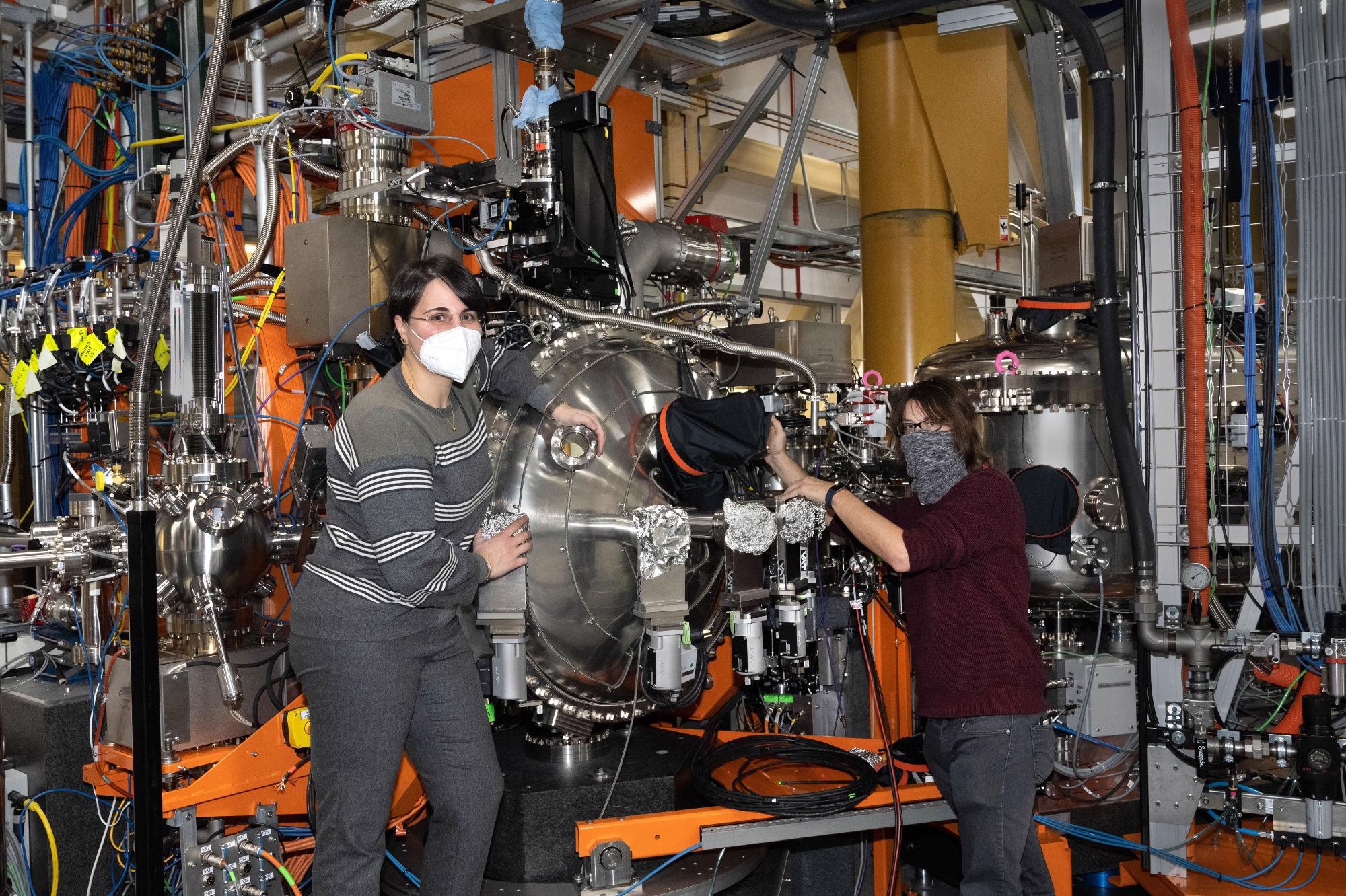Jan 19 2021
A team of researchers from the Brookhaven National Laboratory of the U.S. Department of Energy and from Yale University has successfully controlled spin dynamics in magnetic materials by tuning their thickness. This breakthrough represents a significant feat in the field of spintronics.
 NSLS-II scientists Valentina Bisogni (left) and Jonathan Pelliciari (right) pictured at the Soft Inelastic X-ray Scattering (SIX) beamline, where this research was conducted. Image Credit: Brookhaven National Laboratory.
NSLS-II scientists Valentina Bisogni (left) and Jonathan Pelliciari (right) pictured at the Soft Inelastic X-ray Scattering (SIX) beamline, where this research was conducted. Image Credit: Brookhaven National Laboratory.
Recently published in the Nature Materials journal, the study may lead to electronic devices that are smaller and more energy-efficient.
Instead of searching for different materials that share the right frequencies, we can now alter the thickness of a single material—iron, in this case—to find a magnetic medium that will enable the transfer of information across a device.
Valentina Bisogni, Physicist and Principal Investigator, Brookhaven National Laboratory
Conventional electronics typically depend on charge—an underlying property of electrons—to send data. However, electrical current dissipates heat as it flows through a device, making it hard to design compact devices without the associated risk of overheating and affecting the performance.
To fulfill the need for smaller and more sophisticated electronics, scientists are studying an alternative method based on spin—a different underlying characteristic of electrons.
Spin is similar to charge and can travel throughout a material just like a current. One major difference is that a charge current contains electrons that move physically, while the electrons in a spin “current” do not move and, instead, they hand over the direction of their spin to one another, similar to passing a baton in a relay race—one with an extended chain of “runners” who never, in fact, run.
There is always a need for more memory or storage capacity in electronic devices, and heat dissipation is currently impeding us from creating devices on a smaller scale. Relying on spin instead of charge significantly reduces overheating in devices, so the goal of spintronics is to realize the same device functionalities, or better, that are already known in traditional electronics—without the drawbacks.
Valentina Bisogni, Principal Investigator and Physicist, Brookhaven National Laboratory
So far, neutron scattering techniques have been used to quantify spin dynamics, but in these techniques, bulk samples also need to be studied (multiple grams of the sample simultaneously). But in real-world applications, the material should be reduced to relatively smaller sizes.
“It is very difficult to predict how certain materials will perform at different length scales,” added Bisogni. “Given that many electronic devices consist of a very small amount of material, it is important to study how the properties in a thin film compare to the bulk.”
Hence, to deal with this scientific query, the researchers employed a method known as resonant inelastic x-ray scattering (RIXS) to investigate thin films of iron that have a thickness of just 1 nm.
While the RIXS technique is well known in the scientific field, the new study is just one of a few cases, where scientists have applied this method to investigate spin dynamics in an extremely thin material.
The researchers achieved this feat by using the sophisticated capabilities of the Soft Inelastic X-ray Scattering (SIX) beamline installed at the National Synchrotron Light Source II (NSLS-II), which is a DOE Office of Science User Facility at the Brookhaven National Laboratory.
We were able to perform these measurements by combining the ultrabright x-ray source at NSLS-II with the unparalleled energy resolution and spectrometer at the SIX beamline.
Jonathan Pelliciari, Study Lead Author and Scientist, SIX
Fitted with a 50-foot-long spectrometer arm, the SIX beamline is installed in its own building next to the experimental floor of NSLS-II. The spectrometer arm is long and movable and allows the SIX beamline to achieve an incredibly high energy resolution and disclose the overall movement of electrons and their spin inside a material.
After analyzing the iron in bulk, the researchers confirmed the outcomes from former neutron scattering methods. When they later moved toward thinner materials, they effectively visualized atomic-scale spin dynamics and also learned that thickness could serve as a “knob” for controlling and adjusting spin dynamics.
“It was exciting to see the way in which iron maintained its ferromagnetic properties from the bulk to just a few monolayers,” added Bisogni, who is also the lead beamline scientist at SIX. “With iron being such an elemental and simple material, we consider this to be a benchmark case for studying the evolution of properties as a function of thickness using RIXS.”
“This work is the result of a strong synergy between world-class facilities. In addition to the high-level experiment and characterization study done at NSLS-II, this research would not have been possible without the expertise and state-of-the-art synthesis capabilities from our colleagues at Yale University,” added Pelliciari.
“Because Yale is only two hours away from NSLS-II, I was able to fully participate in the experiment,” stated Sangjae Lee, a graduate student in Charles Ahn laboratory at Yale University. “This experiment was an inspiring opportunity to perform hands-on synchrotron measurements with world-class scientists at NSLS-II.”
Both Lee and Ahn are co-authors of the study.
Scientists from the condensed matter physics and materials science department of the Brookhaven National Laboratory also extended theoretical support for the optimal understanding of the experimental data.
The researchers from SIX will continue to utilize the RIXS technique to visualize material characteristics associated with spintronics. The ultimate objective of the team is to design an “on or off switch” for handling spin dynamics in devices and figure out the fundamental microscopic mechanism.
DOE’s Office of Science has funded the study.
Journal Reference:
Pelliciari, J., et al. (2021) Tuning spin excitations in magnetic films by confinement. Nature Materials. doi.org/10.1038/s41563-020-00878-0.